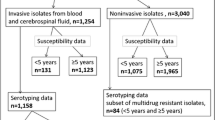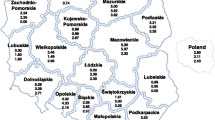Abstract
Pneumonia is a major infectious disease associated with significant morbidity and mortality, with Streptococcus pneumoniae the predominant pathogen in community-acquired cases, accounting for 20% to 50% of bacterial cases. Although pneumococcal resistance to β-lactams is now common worldwide, high-dose parental penicillin G, many other parental β-lactams and some oral β-lactams continue to be efficacious. The new Clinical and Laboratory Standards Institute susceptibility breakpoints for parental penicillin G for nonmeningeal infections (≤2 μg/mL, susceptible; 4 μg/mL, intermediate; ≥8 μg/mL, resistant) introduced in 2008 facilitate appropriate reporting and use of penicillin G. Pneumococcal vaccine usage in children from 2000 has led to significant decreases in morbidity and mortality due to S. pneumoniae in all age groups, and the increase in resistant serotypes, such as 19A, appears to be decreasing following the introduction of an expanded valence vaccine in 2010. Judicious use of antimicrobial agents is the best long-term approach in order to reduce S. pneumoniae resistance.
Similar content being viewed by others
References
Aspa J, Rajas O, Rodriguez de Castro F, et al. Impact of initial antibiotic choice on mortality from pneumococcal pneumonia. Eur Respir J. 2006;27(5):1010–9.
Baddour LM, Yu VL, Klugman KP, et al. Combination antibiotic therapy lowers mortality among severely ill patients with pneumococcal bacteremia. Am J Respir Crit Care Med. 2004;170(4):440–4.
Potgieter PD, Hammond JM. The intensive care management, mortality and prognostic indicators in severe community-acquired pneumococcal pneumonia. Intensive Care Med. 1996;22(12):1301–6.
Tleyjeh IM, Tlaygeh HM, Hejal R, Montori VM, Baddour LM. The impact of penicillin resistance on short-term mortality in hospitalized adults with pneumococcal pneumonia: a systematic review and meta-analysis. Clin Infect Dis. 2006;42(6):788–97.
Paladino JA, Adelman MH, Schentag JJ, Iannini PB. Direct costs in patients hospitalised with community-acquired pneumonia after non-response to outpatient treatment with macrolide antibacterials in the US. Pharmacoeconomics. 2007;25(8):677–83.
Whitney CG, Pilishvili T, Farley MM, et al. Effectiveness of seven-valent pneumococcal conjugate vaccine against invasive pneumococcal disease: a matched case–control study. Lancet. 2006;368(9546):1495–502.
Jacobs MR. Antimicrobial-resistant Streptococcus pneumoniae: trends and management. Expert Rev Anti Infect Ther. 2008;6(5):619–35.
Widdowson CA, Klugman KP. Molecular mechanisms of resistance to commonly used non-betalactam drugs in Streptococcus pneumoniae. Semin Respir Infect. 1999;14(3):255–68.
Hakenbeck R, Kaminski K, Konig A, et al. Penicillin-binding proteins in beta-lactam-resistant streptococcus pneumoniae. Microb Drug Resist. 1999;5(2):91–9.
Fuller JD, McGeer A, Low DE. Drug-resistant pneumococcal pneumonia: clinical relevance and approach to management. Eur J Clin Microbiol Infect Dis. 2005;24(12):780–8.
Klugman KP, Yu VL. No impact of penicillin resistance on mortality. Clin Infect Dis 2006 Jul 15;43(2):261; author reply −2.
Weinstein MP, Klugman KP, Jones RN. Rationale for revised penicillin susceptibility breakpoints versus Streptococcus pneumoniae: coping with antimicrobial susceptibility in an era of resistance. Clin Infect Dis. 2009;48(11):1596–600.
Daneman N, McGeer A, Green K, Low DE. Macrolide resistance in bacteremic pneumococcal disease: implications for patient management. Clin Infect Dis. 2006;43(4):432–8.
Fasola EL, Bajaksouzian S, Appelbaum PC, Jacobs MR. Variation in erythromycin and clindamycin susceptibilities of Streptococcus pneumoniae by four test methods. Antimicrob Agents Chemother. 1997;41(1):129–34.
Jacobs MR, Good CE, Beall B, Bajaksouzian S, Windau AR, Whitney CG. Changes in serotypes and antimicrobial susceptibility of invasive Streptococcus pneumoniae strains in Cleveland: a quarter century of experience. J Clin Microbiol. 2008;46(3):982–90.
Farrell DJ, Couturier C, Hryniewicz W. Distribution and antibacterial susceptibility of macrolide resistance genotypes in Streptococcus pneumoniae: PROTEKT Year 5 (2003–2004). Int J Antimicrob Agents. 2008;31(3):245–9.
Jenkins SG, Brown SD, Farrell DJ. Trends in antibacterial resistance among Streptococcus pneumoniae isolated in the USA: update from PROTEKT US Years 1–4. Ann Clin Microbiol Antimicrob. 2008;7:1.
Janoir C, Zeller V, Kitzis MD, Moreau NJ, Gutmann L. High-level fluoroquinolone resistance in Streptococcus pneumoniae requires mutations in parC and gyrA. Antimicrob Agents Chemother. 1996;40(12):2760–4.
Piddock LJ, Johnson MM, Simjee S, Pumbwe L. Expression of efflux pump gene pmrA in fluoroquinolone-resistant and -susceptible clinical isolates of Streptococcus pneumoniae. Antimicrob Agents Chemother. 2002;46(3):808–12.
Mandell LA, Wunderink RG, Anzueto A, et al. Infectious Diseases Society of America/American Thoracic Society consensus guidelines on the management of community-acquired pneumonia in adults. Clin Infect Dis. 2007;44 Suppl 2:S27–72.
Buckingham SC, Brown SP, Joaquin VH. Breakthrough bacteremia and meningitis during treatment with cephalosporins parenterally for pneumococcal pneumonia. J Pediatr. 1998;132(1):174–6.
Daum RS, Nachman JP, Leitch CD, Tenover FC. Nosocomial epiglottitis associated with penicillin- and cephalosporin-resistant Streptococcus pneumoniae bacteremia. J Clin Microbiol. 1994;32(1):246–8.
Dowell SF, Smith T, Leversedge K, Snitzer J. Failure of treatment of pneumonia associated with highly resistant pneumococci in a child. Clin Infect Dis. 1999;29(2):462–3.
Pallares R, Linares J, Vadillo M, et al. Resistance to penicillin and cephalosporin and mortality from severe pneumococcal pneumonia in Barcelona, Spain. N Engl J Med. 1995;333(8):474–80.
Sacho H, Klugman KP, Koornhof HJ, Ruff P. Community-acquired pneumonia in an adult due to a multiply-resistant pneumococcus. J Infect. 1987;14(2):188–9.
Farrell DJ, Jenkins SG, Brown SD, Patel M, Lavin BS, Klugman KP. Emergence and spread of Streptococcus pneumoniae with erm(B) and mef(A) resistance. Emerg Infect Dis. 2005;11(6):851–8.
Jenkins SG, Farrell DJ. Increase in pneumococcus macrolide resistance, United States. Emerg Infect Dis. 2009;15(8):1260–4.
Klugman KP, Lonks JR. Hidden epidemic of macrolide-resistant pneumococci. Emerg Infect Dis. 2005;11(6):802–7.
Powis J, McGeer A, Green K, et al. In vitro antimicrobial susceptibilities of Streptococcus pneumoniae clinical isolates obtained in Canada in 2002. Antimicrob Agents Chemother. 2004;48(9):3305–11.
Richter SS, Heilmann KP, Beekmann SE, Miller NJ, Rice CL, Doern GV. The molecular epidemiology of Streptococcus pneumoniae with quinolone resistance mutations. Clin Infect Dis. 2005;40(2):225–35.
Weiss K, Restieri C, Gauthier R, et al. A nosocomial outbreak of fluoroquinolone-resistant Streptococcus pneumoniae. Clin Infect Dis. 2001;33(4):517–22.
Davidson R, Cavalcanti R, Brunton JL, et al. Resistance to levofloxacin and failure of treatment of pneumococcal pneumonia. N Engl J Med. 2002;346(10):747–50.
Fuller JD, Low DE. A review of Streptococcus pneumoniae infection treatment failures associated with fluoroquinolone resistance. Clin Infect Dis. 2005;41(1):118–21.
Ho PL, Tse WS, Tsang KW, et al. Risk factors for acquisition of levofloxacin-resistant Streptococcus pneumoniae: a case–control study. Clin Infect Dis. 2001;32(5):701–7.
Kupronis BA, Richards CL, Whitney CG. Invasive pneumococcal disease in older adults residing in long-term care facilities and in the community. J Am Geriatr Soc. 2003;51(11):1520–5.
Jacobs MR, Good CE, Windau AR, et al. Activity of ceftaroline against recent emerging serotypes of Streptococcus pneumoniae in the United States. Antimicrob Agents Chemother. 2010;54(6):2716–9.
Malhotra-Kumar S, Lammens C, Coenen S, Van Herck K, Goossens H. Effect of azithromycin and clarithromycin therapy on pharyngeal carriage of macrolide-resistant streptococci in healthy volunteers: a randomised, double-blind, placebo-controlled study. Lancet. 2007;369(9560):482–90.
Bronzwaer SL, Cars O, Buchholz U, et al. A European study on the relationship between antimicrobial use and antimicrobial resistance. Emerg Infect Dis. 2002;8(3):278–82.
van de Sande-Bruinsma N, Grundmann H, Verloo D, et al. Antimicrobial drug use and resistance in Europe. Emerg Infect Dis. 2008;14(11):1722–30.
Hicks LA, Chien YW, Taylor Jr TH, Haber M, Klugman KP. Outpatient antibiotic prescribing and nonsusceptible Streptococcus pneumoniae in the United States, 1996–2003. Clin Infect Dis Oct. 2011;53(7):631–9.
Shields B. Prevnar (heptavalent pneumococcal conjugate vaccine): disease prevention in infants and children. J Pediatr Health Care. 2001;15(4):203–8. quiz 9–10.
Jacobs MR, Bajaksouzian S, Bonomo RA, et al. Occurrence, distribution, and origins of Streptococcus pneumoniae Serotype 6 C, a recently recognized serotype. J Clin Microbiol. 2009;47(1):64–72.
Nahm MH, Lin J, Finkelstein JA, Pelton SI. Increase in the prevalence of the newly discovered pneumococcal serotype 6 C in the nasopharynx after introduction of pneumococcal conjugate vaccine. J Infect Dis. 2009;199(3):320–5.
Jacobs MR, Good CE, Bajaksouzian S, Windau AR. Emergence of Streptococcus pneumoniae serotypes 19A, 6 C, and 22 F and serogroup 15 in Cleveland, Ohio, in relation to introduction of the protein-conjugated pneumococcal vaccine. Clin Infect Dis. 2008;47(11):1388–95.
Reynolds TA. Update on emerging infections: news from the Centers for Disease Control and Prevention. Emergence of antimicrobial-resistant serotype 19A Streptococcus pneumoniae–Massachusetts, 2001–2006. Ann Emerg Med. 2008;51(3):312–5.
Moore MR, Gertz Jr RE, Woodbury RL, et al. Population snapshot of emergent Streptococcus pneumoniae serotype 19A in the United States, 2005. J Infect Dis. 2008;197(7):1016–27.
Messina AF, Katz-Gaynor K, Barton T, et al. Impact of the pneumococcal conjugate vaccine on serotype distribution and antimicrobial resistance of invasive Streptococcus pneumoniae isolates in Dallas, TX, children from 1999 through 2005. Pediatr Infect Dis J. 2007;26(6):461–7.
Dagan R, Klugman KP. Impact of conjugate pneumococcal vaccines on antibiotic resistance. Lancet Infect Dis. 2008;8(12):785–95.
Disclosure
Dr. M Jacobs has received grant support, consulting fees, travel support, and payment for development of educational presentations from Abbott Pharmaceuticals, ARPIDA Pharmaceuticals, Aventis Pharmaceuticals, Basilea Pharmaceuticals, Bristol-Myers Squibb Pharmaceuticals, Bayer Pharmaceuticals, Cerexa Pharmaceuticals, Daiichi Pharmaceuticals, Dr Reddy’s Laboratory, Eli Lilly & Co., GlaxoSmithKline Pharmaceuticals, Meiji Pharmaceuticals, Ortho-McNeil Pharmaceutical, Pfizer Inc., Ranbaxy Laboratories, Roche Pharmaceuticals, TAP Pharmaceuticals, Warner-Lambert Pharmaceuticals, Wockhardt Pharmaceuticals and Wyeth-Ayerst/Lederle Pharmaceuticals; Dr. S. Jinno reported no potential conflicts of interest relevant to this article.
Author information
Authors and Affiliations
Corresponding author
Rights and permissions
About this article
Cite this article
Jinno, S., Jacobs, M.R. Pneumonia Due to Drug-Resistant Streptococcus pneumoniae . Curr Infect Dis Rep 14, 292–299 (2012). https://doi.org/10.1007/s11908-012-0260-x
Published:
Issue Date:
DOI: https://doi.org/10.1007/s11908-012-0260-x




